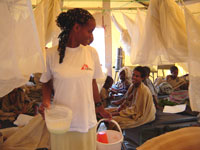Oncethe problem had been identified, MSF took the lead of the response. Thedistrict health center was reorganized to welcome the numerous sickpersons.
Today, close to 100 patients are treated in thiscenter and about the same number are receiving treatment in thecommunity.The first suspectdeaths occurred last fall and their number slowly increased. In thepeak of the epidemic two to three persons were dying every day, sayBura's leaders. Local health authorities first thought it was a malariaoutbreak and treated the patients accordingly. But as the treatmentshowed no results, the MSF team insisted that further test should beperformed. Although this region was not known as a kala azar endemicarea, they thought it could be the cause of so many deaths. Thedoctor's suspicion was finally confirmed through lab tests in earlyMay.
Kala azar, or visceralleishmaniasis, is transmitted by the sandfly. It is estimated that500'000 new cases appear every year in the world. Aftertwo to six months of incubation, the parasite attacks the immunologicdefense of the infected person. The disease is characterized by highfever, swelling of the spleen and important weight loss. If nottreated, the sick die in some months.
Theauthorities and infrastructures of the region were not prepared to facesuch an outbreak.
MSF decided to bring its support bysetting up a kala azar treatment unit in the neighboringAddis Zemen health center. Five tents, each one with capacity for 12patients, have been installed in the compound of the health center. Dueto the avalanche of sick persons, two wards and a corridor of thecenter, originally designed for 10 inpatients, have also beenoccupied.
On admission, a lot of patients arriveseverely malnourished. Therefore, beside the kala azar medication -adaily injection during one month-, most of them need to receive anutritional treatment. Other pathologies originated by the kala azar-such as pneumonia or anemia- need also to be treated. As soon as thepatients' shape improves, they are discharged. Then, a medical teamwill visit them every day in the community to make them an injectionuntil the month of treatment is over.
Themeasures adopted to fight the epidemic are giving fruits.
Most of the patients that are treated in Addis Zemenimprove rapidly. More than 100 of them have already beendischarged, and up to now, only three patients admittedin the center have died: an elder that refused to take the medicationand two children that were very severely malnourished onadmission.
"Most of the persons that wehave been treating had a life expectation of not more than threemonths",
says Yanos Orfanos, anMSF medical doctor. Although new cases still appear, itis hopped that the outbreak decreases with the rainy season that hasjust begun. But a question remains opened: kala azar could be endemicin this region. In this case, new crisis will surely occur.

